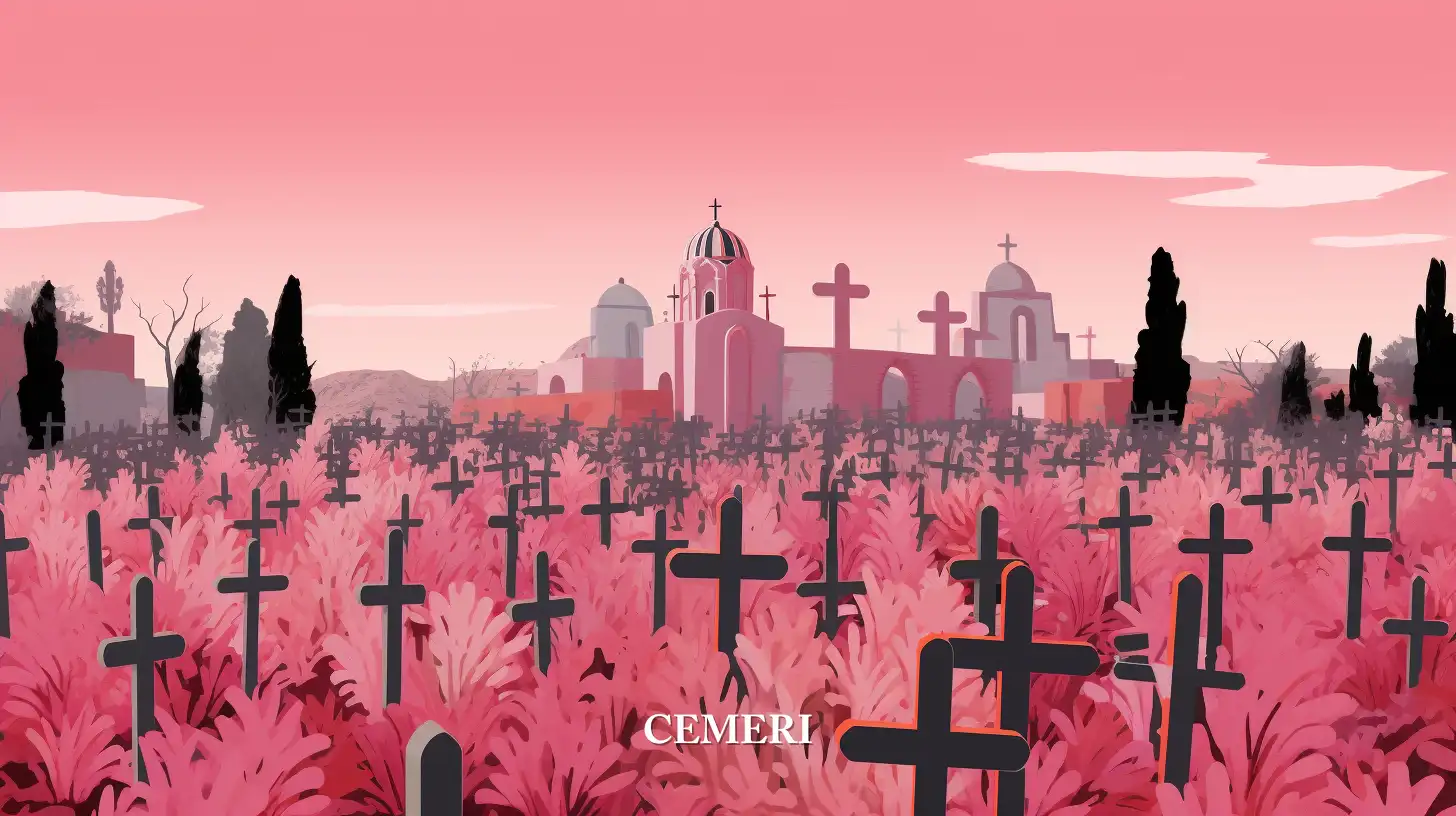Analysis
Veronica A Lira Ortiz
Pink crosses from Ciudad Juárez to Santiago: a brief analysis of femicides at the regional level
- According to data from the United Nations Office on Drugs and Crime (“UNODC”), until 2018, Latin America was the region with the second most femicides and intentional homicides of women in the world, Africa leading the list.

In Latin America, the news promises daily to announce the death of at least one woman or girl at the hands of gender violence. As countless names accumulate, we begin to forget them, there are so many that we lose count. Some are remembered with pink crosses, others with pints that justice exists and some are still waiting to be found.
A femicide is distinguished from an intentional homicide because it involves crimes with gender reasons prior to the death of the woman. That is, for a crime to be considered femicide there must be indicators of sexual or physical abuse and in most cases a previous relationship with the victim. In Latin America, only nine countries recognize femicide as a distinctive crime, differentiating it from aggravated homicide. Among these countries, there are important differences regarding when a murder is considered a femicide, differences that exist even between their federal and state, departmental or provincial levels, as the case may be.
Even with different definitions and legislation, femicides around the world are characterized by having the same element: disparate power relations based on predominantly patriarchal societies. To understand femicide we must begin by understanding what gender violence against women is, since this crime is its most serious manifestation. Not all violence against women should be classified as gender violence. Well, gender violence is distinguished from other forms of violence because it has its origin in gender inequality, the asymmetrical relationship of power and the existence and prevalence of macho or sexist structures and norms.[1] That is, if a woman is killed with a firearm in a robbery, it will be a violent crime and not a gender-based crime against women. On the contrary, if a woman is murdered at the hands of her ex-partner, it is likely that this crime is not only considered gender violence but also femicide.
According to data from the United Nations Office on Drugs and Crime (“UNODC”), until 2018, Latin America was the region with the second most femicides and intentional homicides of women in the world, Africa leading the list. [2] Until then, a femicide was recorded every two and a half hours in Latin American countries. According to data from the Economic Commission for Latin America and the Caribbean (“ECLAC”) in 2019, 4,640 femicides were registered in 23 countries of the region.[3] Understanding these figures usually leads to a analysis of the individual context of the countries, including the impact of gender violence, specific legislation and the behavior of their leaders.
The Mexican case
Mexico is one of the deadliest countries to be a woman. According to data from the National Commission to Prevent and Eradicate Violence Against Women, in 2020, 940 femicides were registered in Mexico, with Chihuahua, Baja California and Nuevo León being the states with the most records. This figure contrasts with that published by activists such as María Salguero in Feminicidios.mx, which amounts to more than 1,250 femicides.[4] According to the report on femicide violence in Mexico presented by UN Women and the National Institute of Women in December 2020, the most dangerous age to be a woman in Mexico is between 20 and 29 years, given the marked increase in the number of femicides in 2019 against women of this age range.[5 ] According to data from the Executive Secretariat of the National Public Security System, in January and February 2021, 142 femicides were registered in Mexico.
In Mexico, femicidal violence is a concept that was incorporated into article 21 of the General Law on Women's Access to a Life of Violence, which defines it as:
The extreme form of gender violence against women, product of the violation of their human rights, in the public and private spheres, made up of the set of misogynistic behaviors that can lead to social and State impunity and can culminate in homicide and other forms of violent death of women.[6]
Femicide was classified as an autonomous crime in Mexico in 2012 in the Federal Penal Code. However, femicide is a common law crime, that is, it is persecuted at the local and federal level, which is why each federal entity has carried out its own criminalization process that has been defined in different ways; local penal codes have established different objectives and sanctions.[7] The criteria for a murder to be considered a femicide contemplated at the federal level by the 32 entities of the country are: that the victim present signs of sexual violence or of any kind; that infamous or degrading injuries or mutilations have been inflicted on the victim, before or after the deprivation of life or acts of necrophilia; and that the body of the victim be exposed or exhibited in a public place.
[ ](https://www.google. com/maps/d/u/0/viewer?mid=174IjBzP-fl_6wpRHg5pkGSj2egE&ll=24.082374421263363%2C-102.17433535797153&z=5)
](https://www.google. com/maps/d/u/0/viewer?mid=174IjBzP-fl_6wpRHg5pkGSj2egE&ll=24.082374421263363%2C-102.17433535797153&z=5)
Map of femicides prepared by María Salguero. Screenshot
The increase in the number of femicides and intentional homicides against women in recent years has provoked the indignation of thousands of women who have taken to the streets on multiple occasions to protest the lax policies regarding the prosecution of said crimes, the lack of resources invested in gender issues and evident impunity. So far in 2021, there have been more than six mobilizations nationwide to protest against gender violence and femicides, with the most massive ones on March 8 and 29.[8]
The Brazilian case
Brazil is the Latin American country with the highest number of registered femicides in recent years. Only in the first half of 2020, according to the Brazilian Public Security Yearbook, 648 femicides were registered in Brazil, 1.9% more than in the same period of 2019, with Sao Paulo and Minas Gerais being the states with the highest number.[\ 9]
In Brazil, the murder of women in contexts marked by gender inequality became in 2015 a serious crime punishable under Law no. 13.104/2015 of its Penal Code.[10] Specifically, femicide is defined as “the murder of women for reasons of female status [involving] domestic and family violence; contempt or discrimination against the condition of women.”[11]
According to Prado and Sanematsu, the bill initially defined femicide as the extreme form of gender violence that resulted in the death of the woman, however this was gradually transformed in order to give more exact guidelines to justice institutions. who would prosecute such crimes. According to a document prepared jointly by UN Women and the Brazilian government in 2016, it will be possible to identify "gender reasons" not only in the scenarios commonly defined in other countries -such as the intimacy between the victim and the aggressor or the family relationship that could have – but also on the following types of murder:[12]
- Child: death of a girl under 14 years of age by a man in a relationship of power or responsibility with the victim.
- By connection: death of a woman who is in the same line, position or place as another who is murdered, be it a friend, relative or stranger.
- Systemic sexual: death of women who have previously been kidnapped, raped, abused or tortured, whether in an organized or disorganized manner.
- For stigmatized prostitution or occupation: murder of a woman who performs sex work or occupations such as stripper, aide-de-camp, masseuse or night dancer committed by one or more men.
- Due to human trafficking/human smuggling: deaths of women produced in a situation of human trafficking or migrant smuggling. -Transphobic: murder of a transgender or transsexual woman because of her gender identity, hatred or rejection of her. -Lesbophobic: death of a woman because of her sexual orientation, hatred or rejection of her. -Racist: murder of a woman for rejection of her ethnic, racial origin or her phenotypic traits.
Regarding the Brazilian case, the sociologist Eleonora Menicucci establishes that femicide “does not constitute an isolated, sudden or unexpected event. On the contrary, it is part of a continuous process of violence, whose misogynistic roots are characterized by the use of extreme violence. Including a wide range of abuses, from verbal, physical and sexual such as rape, to various forms of mutilation and torture.”[13] This process of violence is not exclusive to what happens in Brazil , but rather defines how femicides develop throughout the region and the world.
The Chilean case
In 2019 Chilean women shook the whole world with the protest and performance organized by the collective Las Tesis known as “A rapist in your path”. This demonstration arose after the suicide of a young woman who was raped and whose attacker was not put in prison, however it became the hymn of change not only for Chile but for the rest of Latin America. Specifically in the South American country, the demonstrations against gender violence led to a reform of the 2010 Femicide Law, now known as the Gabriela Law, alluding to the murder of a woman and her mother in 2018 whose attacker released prison by not have a blood or spousal family relationship with the victims.
It was in 2010 when femicide, called femicide in Chile, was incorporated as a crime into the Penal Code under Law 20480 as "the homicide of a woman who is or has been the spouse or cohabitant of the perpetrator of the crime." According to the Chilean Network Against Violence against Women, this original definition of femicide
does not include the real meaning of femicide, because it reduces it to family relationships, ignoring those murders of women that are committed in other areas and that obey the same causes: misogyny, subjugation, oppression, contempt for the life of women, search for control of their sexuality and reproductive capacity. This is how women and girls raped and murdered by acquaintances, friends, strangers, clients and hate crimes against lesbians are outlawed.[14]
After the impact of the case of Gabriela and her mother, the importance of having better and clearer regulations on gender matters was emphasized. The reform to the Chilean Criminal Code modified the initial considerations of the Femicide Law to now expand and consider that "if the perpetrator of the crime described in the previous paragraph is a man and the victim is a woman, the crime will have the name of rape with femicide . [As well as] whoever, on the occasion of rape, also commits homicide on a woman, the crime will be called rape with femicide.” That is, as long as there are gender reasons, even without being related to the victim, it will be considered a femicide. Additionally, it will be considered that there will be aggravating circumstances in the following circumstances:[15]
- The victim is pregnant.
- The victim was a girl or an adolescent under eighteen years of age, an elderly woman or a woman with a disability. -When the victim has been killed in the presence of her ancestors or descendants.
- When perpetrated in the context of habitual physical or psychological violence by the perpetrator against the victim.
Even with the recent reforms to Chilean laws, according to figures from the National Women's Service, 131 victims of femicide were registered in Chile and in 2020 alone, 151 frustrated femicides were registered. Although this figure is not comparable to countries like Mexico or Brazil, it is important to highlight the role of civil society in modifying Chilean laws and expanding the definition of femicide.
Final thoughts
In Mexico, the efforts to address and eradicate femicide have not been null, but its establishment is still difficult due to the lack of prioritization, resources, and the detachment by the policy of patriarchal behaviors. The head of the Secretary of Security and Citizen Protection, Rosa Icela Rodríguez, announced in 2021 that the state coordinations have implemented training for police officers, the creation of a specialized care body made up of women, and the preparation of a protocol for care of femicide violence. [16]
Intentional homicides or those classified as "crimes of passion" are not recognized as femicides due to political, partisan, and a lack of gender perspective in the police and justice forces, who err in the analysis of the evidence. Whether it is Mexico or the rest of Latin America, gender violence and femicide are deeply influenced by political interests, by administrations that seek to hide how much they have failed their women, governments that fear for a bad reputation and the lack of perspective of gender that continues to blame victims and place abusers in power.
Be Brazil with President Jair Bolsonaro expressing himself misogynistically about Brazilian women[17]; Mexico with gubernatorial candidates accused of sexual abuse and rape, such as Félix Salgado Macedonio[18]; or Chile with government repression of activists and protesters, gender violence is a structural and systemic issue. Even when important legal reforms are made regarding the prosecution of femicides and crimes against women, until the governments and cacicazgos governed by patriarchal figures cease, femicides in the region will continue to increase. What began as a desert of pink crosses in Ciudad Juárez now extends like a plain full of altars and injustice.
Sources
[1] UN WOMEN. Preguntas frecuentes: Tipos de violencia contra las mujeres y las niñas https://www.unwomen.org/es/what-we-do/ending-violence-against-women/faqs/types-of-violence [2] UNODC, Global Study on Homicide 2019 (United Nations, 2019)
[3] Gender Equality Observatory for Latin America and the Caribbean. Femicide or feminicide. https://oig.cepal.org/en/indicators/femicide-or-feminicide
[4] María Salguero. Los feminicidios en México. https://feminicidiosmx.crowdmap.com/
[5] María de la Paz López Barajas et al. Informe de Violencia Feminicida en México: Aproximaciones y Tendencias (Entidad de las Naciones Unidas para la Igualdad de Género y el Empoderamiento de las Mujeres, 2020).
[6] Cámara de Diputados del H. Congreso de la Unión, Ley General de Acceso de las Mujeres a una Vida Libre de Violencia, Diario Oficial de la Federación, 1 de febrero de 2007.
[7] Cámara de Diputado del H. Congreso de la Unión, Código Penal Federal, última reforma publicada en el Diario Oficial de la Federación el 14 de junio de 2012, art. 325.
[8] Expansión Política, El reclamo por feminicidios regresó a Palacio Nacional con una protesta nocturna (Revista Expansión, 2021) https://politica.expansion.mx/mexico/2021/03/29/el-reclamo-por-feminicidios-regreso-a-palacio-nacional-con-una-protesta-nocturna [9] Samira Bueno y Renato Sérgio de Lima, Anuário Brasileiro de Segurança Pública 2020 (Fórum Brasileiro de Seguranca Pública, 2020) https://forumseguranca.org.br/wp-content/uploads/2020/10/anuario-14-2020-v1-interativo.pdf
[10] Assessoria de Comunicacao do IBDFAM Brasil teve 648 casos de feminicídio no primeiro semestre de 2020. (Instituto Brasileiro de Direito de Familia, 2020). https://ibdfam.org.br/index.php/noticias/7853/Brasil+teve+648+casos+de+feminic%C3%ADdio+no+primeiro+semestre+de+2020 [10] Débora Prado y Marisa Sanematsu, Feminicídio: InvisibilidadeMata (Instituto Patrícia Galvão, 2017)
[11] S/A, “Dos crimes contra a vida” en Código Penal Brasil. (Presidencia de la República Casa Civil para Asuntos Jurídicos, 2020).
[12] ONU Mulheres, Diretrizes Nacionais Feminicídio (Entidade das Nações Unidas para a Igualdade de Gênero e o Empoderamento das Mulheres – ONU Mulheres, 2016).
[13] Ministério da Mulher, da Família e dos Direitos Humanos, 2015. https://www.gov.br/mdh/pt-br/noticias-spm/noticias/integra-do-discurso-da-ministra-eleonora-menicucci-na-cerimonia-de-sancao-da-lei-do-feminicidio
[14] Red Chilena contra la Violencia hacia las Mujeres. http://www.nomasviolenciacontramujeres.cl/registro-de-femicidios/ [15] Catalina Díaz, Yessenia Márquez y Daniela Salgado, Ley de Femicidios y Ley Gabriela, las deudas y desafíos pendientes (BioBioChile, 2020) https://www.biobiochile.cl/especial/8m/noticias/2020/03/08/ley-de-femicidios-y-ley-gabriela-las-deudas-y-desafios-pendientes.shtml
[16] Redacción Animal Político. Feminicidios en México se concentran en el 18% de los municipios; Juárez, el lugar con más casos. (Animal Político, 2021) https://www.animalpolitico.com/2021/01/femincidios-mexico-resultados-estrategia-violencia-mujeres/
[17] Marina Rossi, La misoginia del Gobierno de Bolsonaro termina en la justicia. (El País, 2020)https://elpais.com/internacional/2020-08-12/la-misoginia-del-gobierno-de-bolsonaro-termina-en-la-justicia.html
[18] Maya Averbuch, Félix Salgado y sus señalamientos por abuso sexual: la ‘gota que derramó el vaso’ para dividir a Morena. (El Financiero, 2021) https://www.elfinanciero.com.mx/nacional/felix-salgado-y-sus-senalamientos-por-abuso-sexual-la-gota-que-derramo-el-vaso-para-dividir-a-morena/

